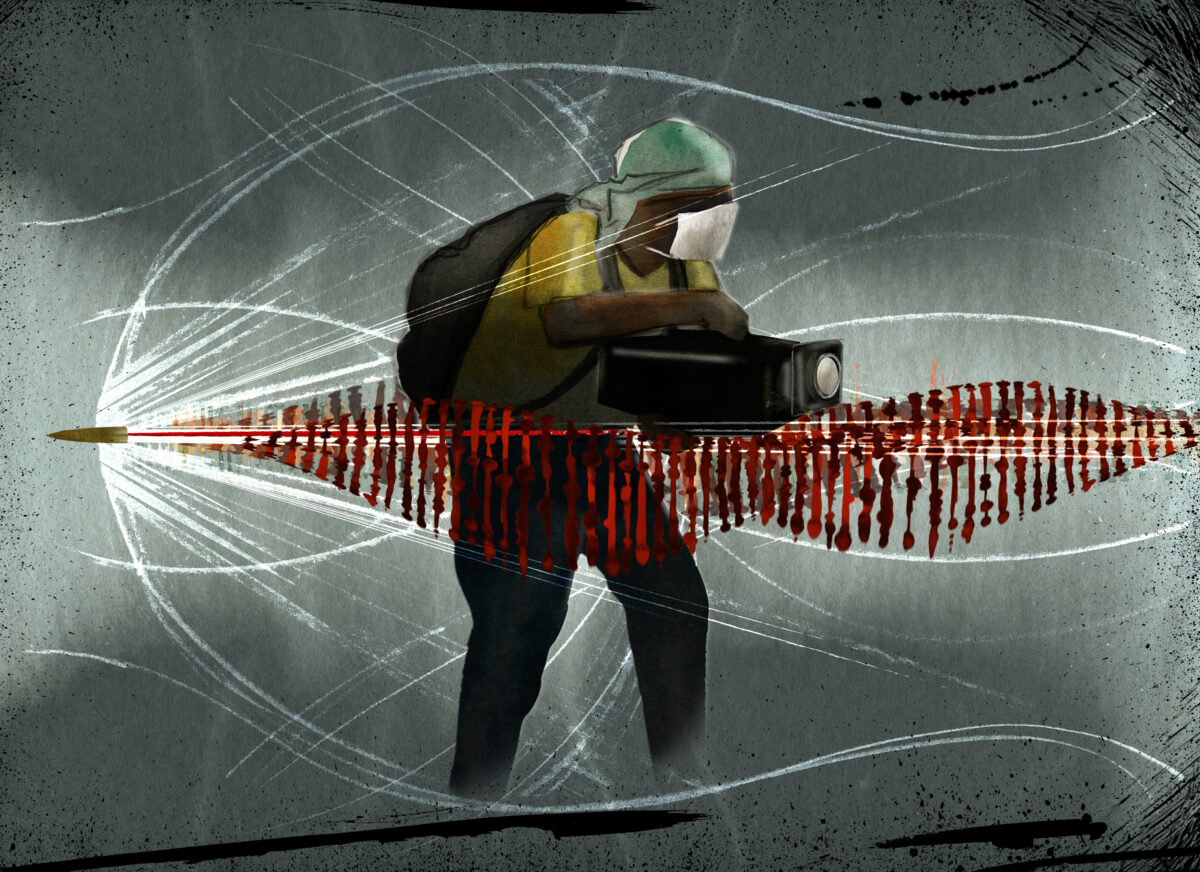What Audio Analysis Reveals About Aid Workers Killed in Gaza
On March 23, the Israel Defense Forces (IDF) announced an operation in southern Gaza’s Tal as-Sultan neighborhood and urged civilians to evacuate using a road north to a humanitarian zone. Hours before the statement was shared online, a rescue convoy was traveling along that same road before all contact was lost. The convoy was made up of aid workers from the Palestine Red Crescent Society (PRCS), Palestine Civil Defense and the United Nations.
At least four vehicles, clearly marked by their emergency flashing lights, were present and had stopped beside another vehicle that was located just off the road when the shooting started.
An almost seven-minute video, recovered from a phone on one of the bodies of the deceased and released by the PRCS recorded what happened next. Although much of the footage is dark, the audio provides some clues about events that unfolded. An extended 20-minute version of the original seven-minute video has since been released by the PRCS on April 8.
Bellingcat conducted a preliminary analysis of the recording and broke down the audio. We then consulted two audio forensic experts who confirmed the total shots fired numbered in the hundreds.
The majority of gunshots heard during the shooting appear to feature supersonic shockwaves, which seems to indicate bullets travelled toward the recording microphone held by the aid worker. The audio evidence also appears to confirm that the first shots were aimed at the medics’ convoy from a distance of approximately 40 to 45 metres.
Following the incident, IDF spokesperson Lieutenant Colonel Nadav Shoshani initially denied the PRCS ambulances were randomly fired upon and claimed the vehicles were “advancing suspiciously toward IDF troops without headlights or emergency signals.” Following this, troops opened fire on the vehicles.
However, after the emergence of the seven-minute video recorded by one of the PRCS members — first reported by The New York Times and then released by the PRCS — which showed the vehicles had their emergency lights and headlights on, the IDF released another statement on April 7. This outlined that, following a preliminary inquiry into the incident, the Chief of the General Staff had instructed that a more in-depth investigation would be carried out by the General Staff investigation mechanism. This process is typically enacted by the IDF to determine whether a criminal investigation should be opened into an incident.
A video shared by the United Nations on March 30 showed bodies clad in emergency vests as they were retrieved from a shallow grave. The remains of emergency vehicles were also retrieved.
Geolocating the Seven-Minute Video
We were able to confirm where the footage was filmed using two large concrete structures silhouetted on the horizon to the left of the road (highlighted below in red). There are also newer temporary structures visible on the right hand side of the road (highlighted in blue). We matched these identifiers from the video with more recent SkySat imagery from Planet Labs, finding they lined up with an area on Gush Katif Road just north of Tal as-Sultan.
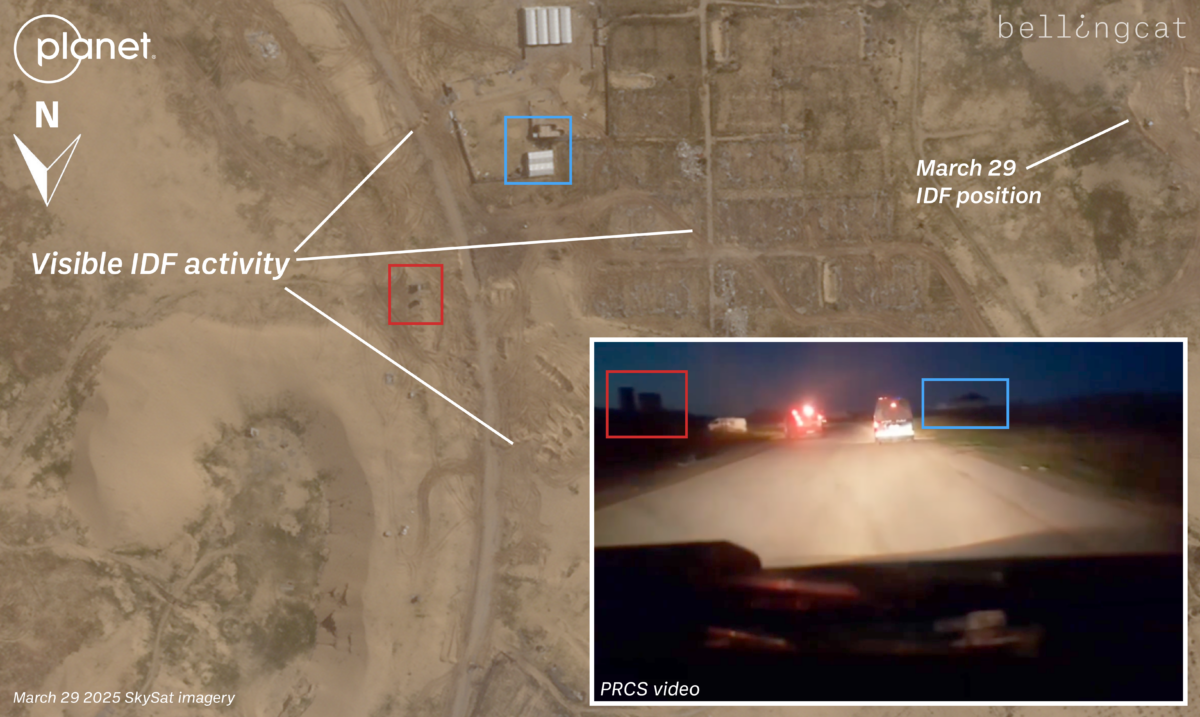
Using the chronolocation tool SunCalc, Bellingcat was also able to confirm the video was filmed in the early hours of the morning — something also confirmed by The New York Times. The video shows sunlight on the horizon to the east, and computing the sunlight for March 23 at 5:00am local time for this location shows that the sun would be in around the same position.
Breaking Down the Audio
Bellingcat has previously used audio forensic analysis to investigate the killing of journalists Shireen Abu Akleh and Abelardo Liz and has compared the sound of live rounds against witness testimonies and official statements.
Most rifle ammunition available today is faster than the speed of sound (supersonic). The muzzle velocities of bullets fired by such rifles are typically in the range of 650 to 1,000 metres per second (m/s).
When supersonic rounds are fired, the first thing heard by a person — or camera — in the line of fire is the shockwave (crack sound) caused by the passing bullet, followed by the respective muzzle blast (bang sound) which travels much slower at the speed of sound. There is a time gap or delay between both since the bullet travels faster than the bang. Watch our video from a previous investigation for a more detailed explanation.
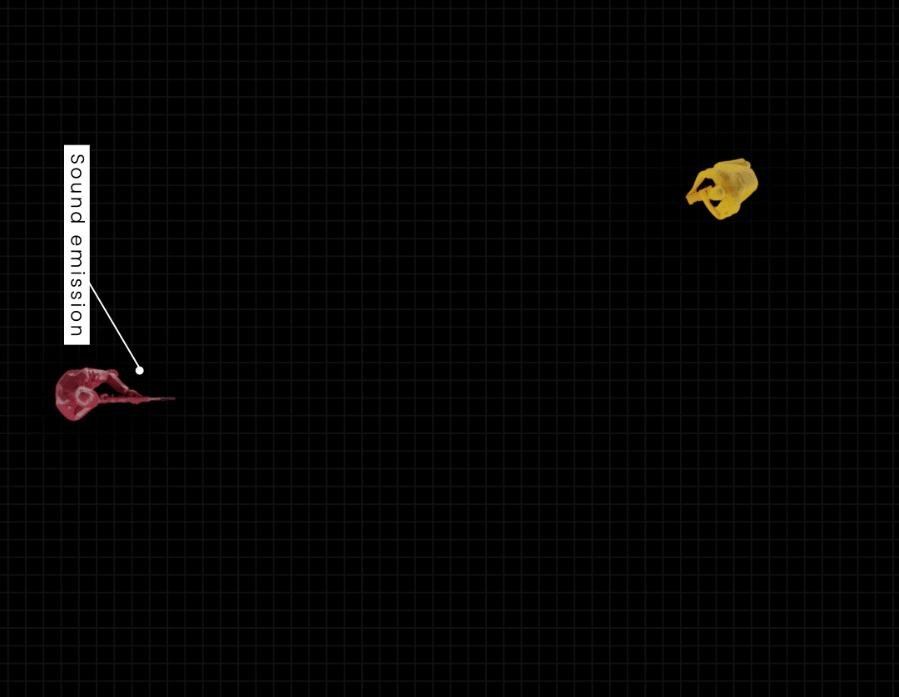
We noted that the first minute of the seven-minute video recording released by the PRCS shows the vehicles driving along the road and no gunfire can be heard.
The shooting recorded in the video begins at approximately 1:17, with a series of rapid gunshots featuring what appears to be shockwaves (cracks).
How Many Shots were Fired?
We counted approximately 150 of these crack sounds during the first 30 seconds of the shooting. However, this estimate likely includes not only primary gunshot shockwaves but also some echoes and reflections, which are difficult to differentiate as the highly overlapped series evolved.
Audio forensic experts Dr Robert Maher, Professor of Electrical and Computer Engineering at the State University of Montana, and Steven Beck of Beck Audio Forensics told Bellingcat there were likely hundreds of gunshots fired during the approximately five minute incident.
Dr Maher told us that 27 of these gunshots appeared to occur in the first three seconds of the shooting alone.
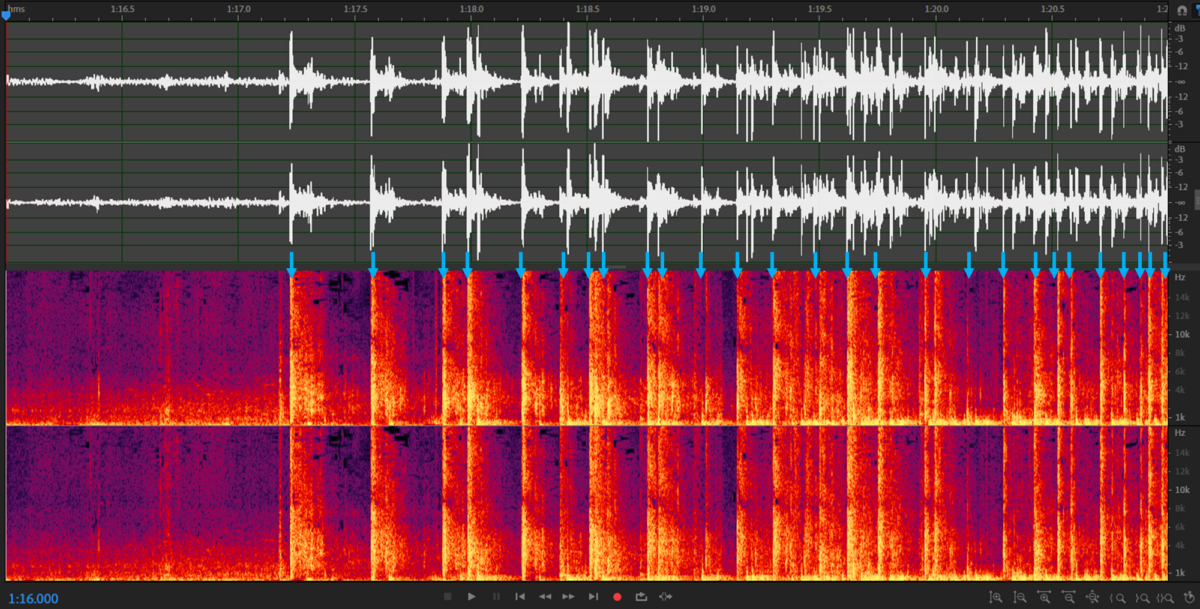
The Shooters
The majority of gunshots heard during the shooting appear to feature supersonic shockwaves. Dr Maher explains that the audible gunshots have the “crack-bang” characteristic, indicating bullets were traveling generally toward the recording microphone, which on this occasion was held by the aid worker.
Bellingcat noticed there were different time gaps between crack sounds and the respective muzzle blasts in the audio. We shared instances of these gunshots with the experts to calculate the distance to the shooters during those moments.
Dr Maher measured the crack-muzzle blast timing of the first gunshots to be about 76 or 77 milliseconds and that the firearm appears to have been about 45 metres from the microphone. Steven Beck estimated the distance to be 40 metres. According to Beck there appeared to be at least three shooters at the start of the shooting. Both experts assumed a bullet speed of 800-1000 m/s respectively for their calculations.
These distances are consistent with one eyewitness, who, according to The New York Times, was being held nearby by the IDF at the time. He was quoted as saying that Israeli soldiers opened heavy fire on the aid workers from a distance of approximately 50 metres.
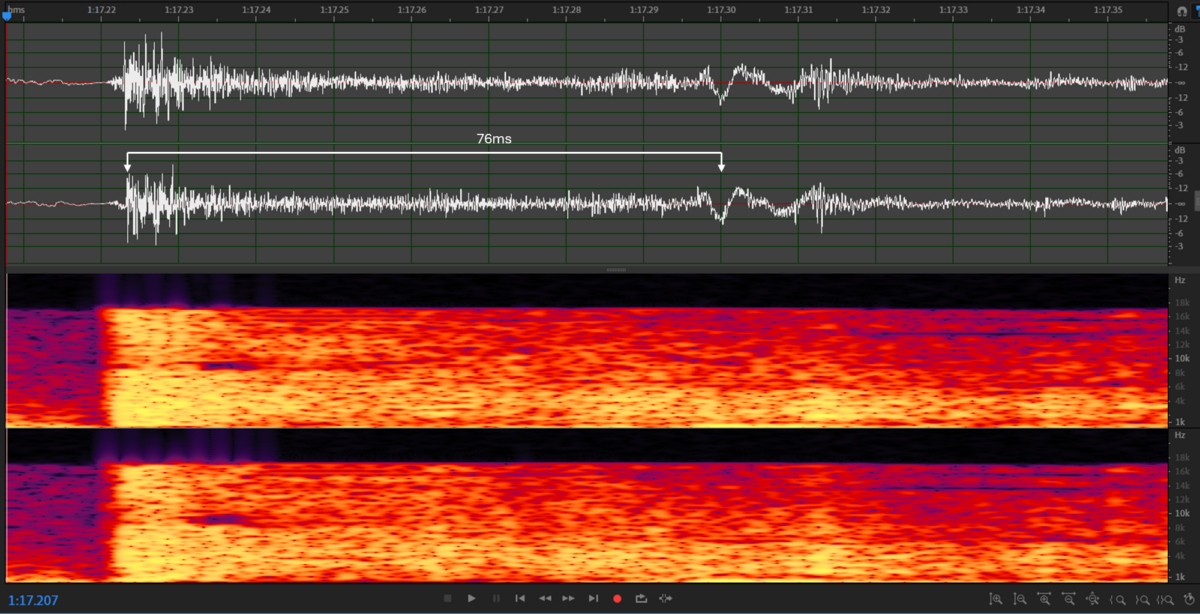
In a later sequence at minute 4:10 in the seven-minute footage, there is a five-shot sequence with various apparent shock waves and muzzle blasts. Both audio forensic experts found the timing between these sounds to be about 50 milliseconds, suggesting a distance of 30 metres.
In other instances towards the end of the video, the timing between the cracks and the muzzle blasts appears to be narrower (42 and 20 milliseconds), meaning these weapons were likely closer to the aid workers’ convoy.
Dr Maher indicated that given the vast number of gunshots, it seems there were likely multiple shooters involved over a range of distances.
Without any visual evidence, it is not clear if the shooters were getting closer to the aid convoy as they fired. It’s also not possible to rule out an exchange of gunfire due to the high number of shots and overlapping sounds. However, details from the audio indicate that on at least two occasions the shooting heard was initiated by gunmen who were firing in the direction of the convoy as opposed to firing from the convoy.
Shooting Patterns and Weapons Used
The shooting, heard in the recording, lasted approximately five minutes and included several intervals of heavy and intermittent fire as well as some pauses.
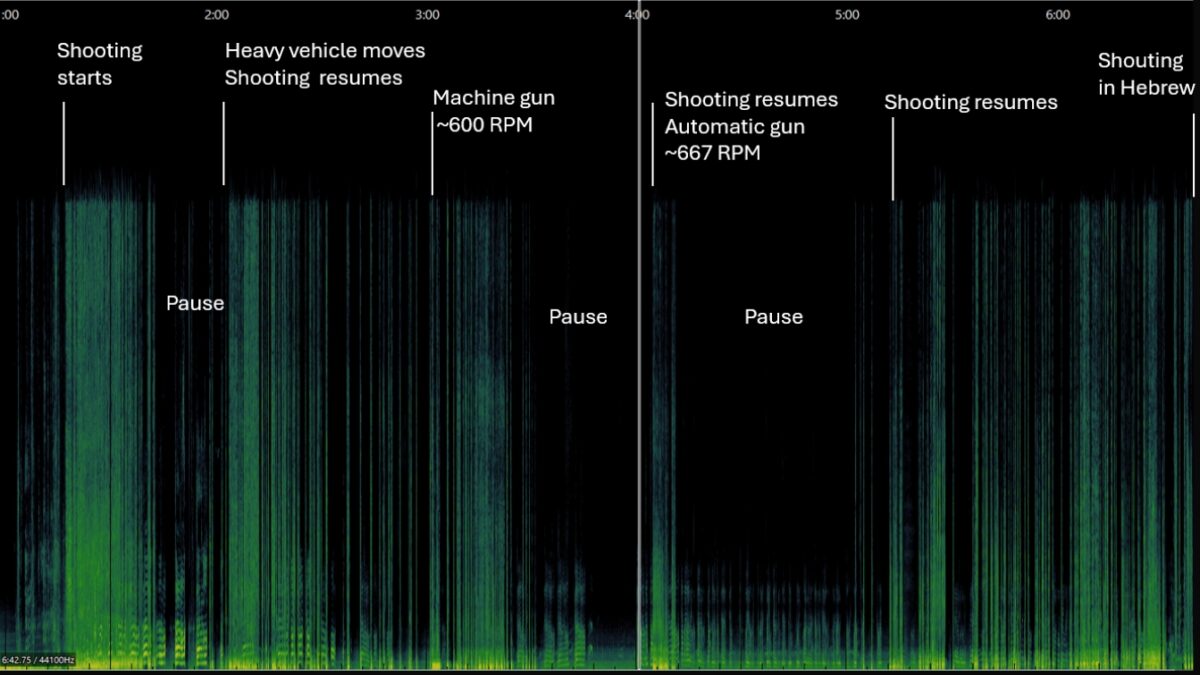
After the initial intense burst of gunfire, there is a pause lasting about 15 seconds. You can hear this at 1:43 in the recording. At approximately 1:58 the shooting resumed. Again, the gunshots appear to feature crack sounds, and at least one ricochet, which seems to indicate that bullets were likely shot in the direction of the aid workers’ convoy.
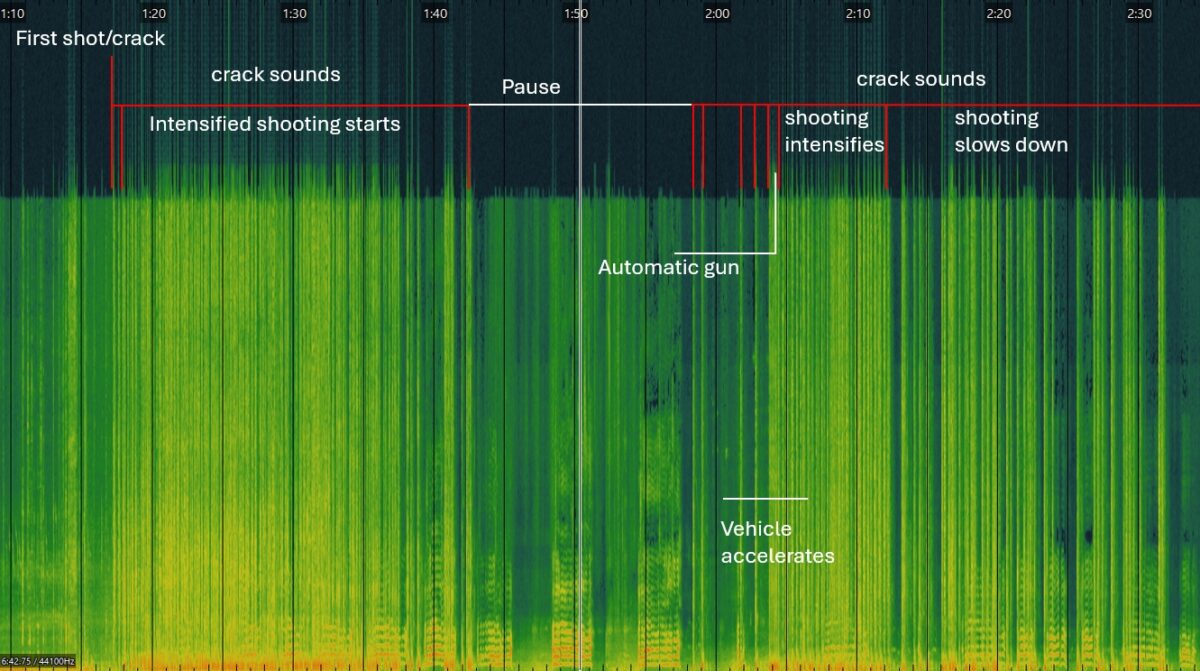
Between 2:35 and 2:57 there appear to be 14 gunshots from a firearm, also featuring very consistent ballistic shockwaves, which, according to Beck, all are from about the same distance of approximately 40 metres from the convoy.
Right after this, at 3:01, a more rapid burst of gunfire is heard. Both experts estimated this to be consistent with a machine gun firing at 600 rounds per minute (22 shots in 2 seconds) and featuring supersonic shockwaves. We identified another potential automatic gun resuming fire towards the convoy after a pause at 4:05.

Our analysis shows that even after brief pauses in the shooting, it resumed several times over the course of approximately five minutes. It is not clear from the available data why the shooting continued for such a sustained period and seems to have included the use of machine guns.
IDF Response
Bellingcat asked the IDF if there was any evidence that anyone in the convoy was armed or returned fire during the incident and whether they believed their response in this case was proportional to the threat posed.
In response, the IDF told Bellingcat the incident is still under examination. On Monday, April 7, the IDF released a statement saying that following a preliminary inquiry into the incident the Chief of the General Staff has instructed that a more in-depth investigation would be carried out by the General Staff investigation mechanism.
This process is typically enacted by the IDF to determine whether a criminal investigation should be opened into the incident.
The IDF’s statement on Monday outlined that the “preliminary inquiry indicated that the troops opened fire due to a perceived threat following a previous encounter in the area.” Adding that six of the people killed were identified as Hamas members. Though the IDF did not provide evidence to support this.
“All the claims raised regarding the incident will be examined through the mechanism and presented in a detailed and thorough manner for a decision on how to handle the event,” they said.
The claim that any of the workers were militants has been denied by a survivor of an earlier attack PRCS paramedic Munther Abed, who said the entire crew was civilian.
The Palestine Red Crescent has called for an independent investigation into the incident.
Protection of Medics Under International Law
Though only a preliminary analysis of the audio from one recording at the scene, this evidence indicates that a huge number of shots were fired towards the aid workers, who were clearly marked. Audio experts also suggested there were multiple shooters involved.
We presented the available evidence to Morris Tidball-Binz, UN Special Rapporteur on extrajudicial, summary or arbitrary executions who told us:
“The arbitrary killing of health workers amounts to a grave violation of international human rights law (i.e. the absolute and inderogabile prohibition of arbitrary killings); a grave breach of International Humanitarian Law and of international criminal law; and it amounts to the war crime of willful killing and of intentional attack against protected medical personnel and transport carrying an emblem of the Geneva Convention.”
He told us the incident must be thoroughly investigated, and a failure to do so may constitute a violation of the right to life under international law.
Bellingcat is a non-profit and the ability to carry out our work is dependent on the kind support of individual donors. If you would like to support our work, you can do so here. You can also subscribe to our Patreon channel here. Subscribe to our Newsletter and follow us on Bluesky here and Mastodon here.
